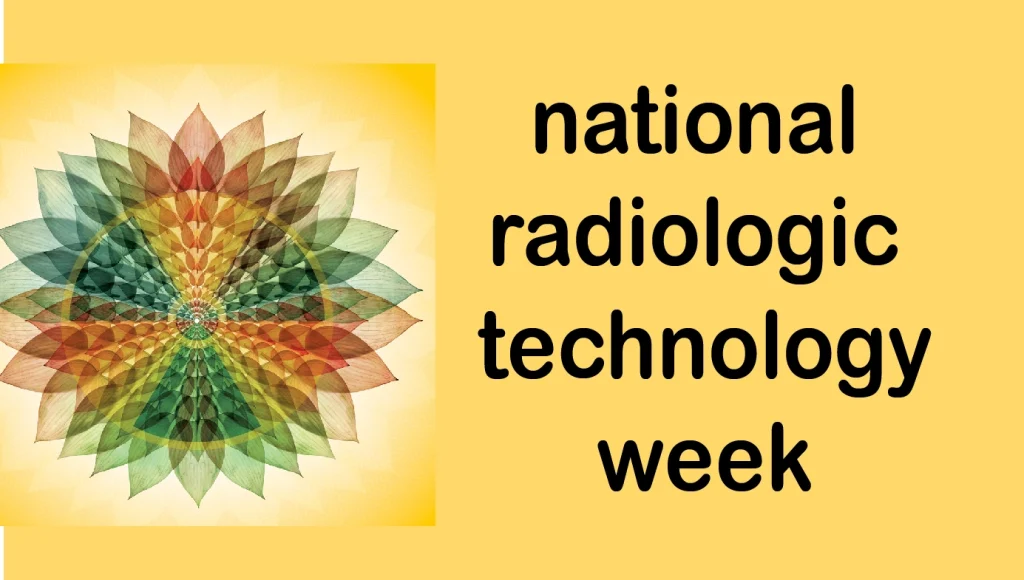Welcome to the blog post that celebrates National Radiologic Technology Week and honors the incredible contributions of radiologic technologists! From capturing images that unveil hidden truths within our bodies to assisting doctors in making life-saving diagnoses, these unsung heroes play a vital role in modern healthcare. Join us as we dive into their fascinating world, shining a spotlight on their skills, dedication, and unwavering commitment to patient care. Get ready for an enlightening journey through the corridors of medical imaging technology!
What is National Radiologic Technology Week?
National Radiologic Technology Week, also known as NRTW, is an annual event that takes place during the first week of November. This special week was established by the American Society of Radiologic Technologists (ASRT) to recognize and celebrate the important contributions of radiologic technologists in the medical field.
Radiologic technologists, also known as radiographers or x-ray technicians, are healthcare professionals who perform diagnostic imaging procedures such as X-rays, CT scans, MRIs, and mammograms. National Radiologic Technology Week They work closely with physicians and other healthcare professionals to produce high-quality images that aid in diagnosing and treating various medical conditions.
Each year, ASRT selects a theme for NRTW to highlight a specific aspect of the profession. The theme for 2021 is “Radiologic Technologists: Positioned For A Vital Role”. This theme aims to showcase how radiologic technologists are constantly evolving and adapting to advancements in technology while remaining at the forefront of patient care.
The History of Radiologic Technology and its Evolution
The field of radiologic technology has come a long way since its humble beginnings in the late 19th century. What started as a simple experiment with X-rays has now evolved into a vital and sophisticated branch of healthcare that plays a crucial role in diagnosing and treating various medical conditions.
The discovery of X-rays by Wilhelm Roentgen in 1895 marked the beginning of radiology. With this groundbreaking discovery, doctors were able to see inside the human body without having to perform surgery. The first X-ray was taken on Roentgen’s wife’s hand, which revealed her bones and wedding ring, causing great excitement and interest among the medical community.

In the early 1900s, X-rays were primarily used for diagnosing bone fractures and locating foreign objects in the body. However, it wasn’t until World War I that their full potential was recognized. During this time, X-rays became an essential tool for treating wounded soldiers on the battlefield.
As technology advanced, so did radiologic techniques. In 1913, George Eastman introduced a film coated with silver bromide emulsion, replacing glass plates used previously for imaging. This made it easier to produce images and allowed for better quality and faster processing times.
The Role of Radiologic Technologists in Healthcare
The role of radiologic technologists in healthcare is a vital and essential one. These professionals play a crucial part in the diagnosis, treatment, and management of various medical conditions. Their expertise in operating imaging equipment and performing diagnostic procedures makes them an integral part of the healthcare team.
One of the primary responsibilities of radiologic technologists is to produce high-quality images that aid physicians in diagnosing and treating patients. From X-rays to ultrasounds to CT scans, these professionals are trained to use different types of imaging technology to capture images of the internal structures of the body. National Radiologic Technology Week These images help doctors identify abnormalities or injuries that may not be visible on the surface, leading to accurate diagnoses and appropriate treatments.
Challenges Faced by Radiologic Technologists
Radiologic technologists play a crucial role in the field of healthcare by utilizing advanced imaging technology to diagnose and treat various medical conditions. However, this profession is not without its challenges. In this section, we will discuss the common challenges faced by radiologic technologists.
1. Physical Demands:
Working as a radiologic technologist requires long hours of standing and frequent movement to position patients for imaging procedures. This can lead to physical strain on their bodies, especially in areas such as the back, neck, shoulders, and wrists. National Radiologic Technology Week The heavy protective gear worn during certain procedures can also contribute to musculoskeletal injuries. It is essential for radiologic technologists to maintain proper posture and take breaks throughout their shifts to prevent these issues.
2. Exposure to Radiation:
The use of radiation in medical imaging procedures exposes radiologic technologists to potential health risks if proper safety measures are not followed. Although the level of exposure is low and regulated, prolonged or repeated exposure can lead to long-term health problems such as cancer or cataracts. To mitigate these risks, strict safety protocols must be followed at all times.
3. Technological Advancements:
Technology in the field of medical imaging is constantly evolving, which means that National Radiologic Technology Week need to continually update their skills and knowledge about new equipment and techniques. Keeping up with these advancements can be challenging and requires ongoing training and education.
4. High-Stress Work Environment:
Radiology departments often have high patient volumes with tight schedules, leading to a fast-paced work environment for National Radiologic Technology Week. They must work quickly while maintaining accuracy and attention to detail to produce quality images for accurate diagnoses. Additionally, they may encounter difficult or uncooperative patients who require extra care or patience during procedures.
5. Emotional Strain:
Radiologic technologists also face emotional challenges due to the nature of their work dealing with patients who may be experiencing pain or anxiety during diagnostic procedures; some may even be receiving life-altering news. National Radiologic Technology Week This aspect of the job can take an emotional toll on radiologic technologists and requires them to have strong communication and empathy skills.
Radiologic technologists face a unique set of challenges in their line of work. However, despite these challenges, they continue to play a vital role in the healthcare system by providing essential diagnostic services. It is crucial to recognize and appreciate the hard work and dedication of these professionals during National Radiologic Technology Week and beyond.
READ MORE ARTICLE:SKYECH SOLUTION
Celebrating and Honoring Radiologic Technologists during National RT Week
National Radiologic Technology Week, also known as RT Week, is an annual event that takes place during the first full week of November. This week is dedicated to celebrating and honoring the hardworking and dedicated professionals in the field of radiology – radiologic technologists.
During this special week, hospitals, imaging centers, and other healthcare facilities across the country take the time to recognize and appreciate the important contributions of National Radiologic Technology Week. It is a time to highlight their vital role in patient care and acknowledge their commitment to excellence in providing high-quality diagnostic imaging services.
One way that organizations show their appreciation for radiologic technologists during National RT Week is by hosting events and activities that celebrate their achievements. These can include award ceremonies, staff lunches or dinners, educational seminars, open houses for the public to learn about medical imaging technology, or even fun team-building activities.
Another great way to honor radiologic technologists during National RT Week is by creating awareness about their profession among patients and the general public. National Radiologic Technology Week Many people are unaware of everything that goes into producing accurate diagnostic images – from positioning patients correctly to operating advanced imaging equipment – all while ensuring patient safety at all times. By educating others about radiologic technology and its crucial role in modern healthcare, we can help people understand and appreciate this profession better.
Impact of Radiologic Technology on Patient Care
Radiologic technology has played a crucial role in revolutionizing patient care. This innovative field utilizes advanced imaging techniques to diagnose and treat various medical conditions, allowing for more accurate and timely interventions. From X-rays to CT scans, radiologic technology has significantly impacted patient care in numerous ways.
One of the most significant impacts of radiologic technology on patient care is its ability to aid in early detection and diagnosis of diseases. National Radiologic Technology Week With the use of imaging techniques such as mammograms and ultrasounds, medical professionals can identify potential health issues at an early stage before they become more serious or life-threatening. For example, a routine chest X-ray can detect lung cancer at an early stage, leading to better treatment outcomes and potentially saving lives.
Advancements in the Field of Radiology and Future Outlook for Radiologic Technologists
The field of radiology has undergone significant advancements over the years, thanks to technological innovations and continuous research. This has not only transformed the way medical imaging is performed but has also opened up new possibilities in patient care. As we celebrate National Radiologic Technology Week and honor the vital role played by radiologic technologists, it is important to take a look at some of these advancements and their impact on the future outlook for radiologic technologists.
One major advancement in radiology is the development of digital imaging technology. Traditional film-based X-rays have been replaced by digital X-rays, which provide higher quality images with lower radiation exposure. National Radiologic Technology Week Digital imaging also allows for faster processing and easier storage and sharing of images, making it more efficient for both patients and healthcare providers.
Conclusion: Thanking our Unsung Heroes in Healthcare
As National Radiologic Technology Week comes to a close, it is important to take a moment to reflect on the vital role that radiologic technologists play in the healthcare system. These unsung heroes work tirelessly behind the scenes, often without receiving the recognition they deserve. They are an essential part of the healthcare team and their contributions should not go unnoticed.
National Radiologic Technology Week are responsible for performing diagnostic imaging procedures such as X-rays, MRIs, CT scans, and ultrasounds. These images assist physicians in diagnosing and treating various medical conditions. Without these skilled professionals, many diagnoses would be delayed or missed altogether.
MUST READ:How Phase Technology is Transforming Industries| 7 Best Headings




